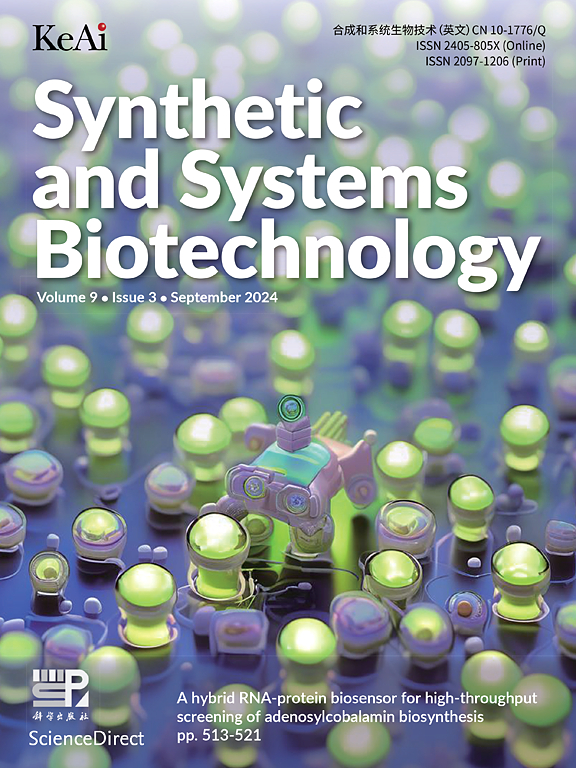Enhanced microbial production of pyridoxine (Vitamin B6) in Bacillus subtilis via pathway and process optimization
IF 4.4
2区 生物学
Q1 BIOTECHNOLOGY & APPLIED MICROBIOLOGY
引用次数: 0
Abstract
Vitamin B6 refers to a family of water-soluble B vitamin, which is essential for various physiological functions, including amino acid metabolism, neurotransmitter synthesis, and hemoglobin synthesis. The biosynthesis of pyridoxine (PN), a commercial form of vitamin B6, through microbial fermentation has garnered widespread attention owing to its environmentally friendly and safe production methods, as well as its mild reaction conditions. However, the low yield of natural strains limits their application. This study focused on constructing a high-yielding strain of PN through pathway engineering and process optimization. Firstly, five key deoxyxylulose-5-phosphate-dependent pathway genes (epd, pdxB, serC, pdxA, and pdxJ) were overexpressed in Bacillus subtilis ARTP, which improved the PN titer by 3.2-fold to 2.9 mg/L. Subsequently, pdxST genes involved in the DXP-independent pathway were screened from various strains. Ribosome binding site (RBS) sequences were optimized to regulate their expression, which further increased the PN titer to 24.6 mg/L. Finally, systematic medium optimization was identified as a critical strategy for enhancing PN biosynthesis, leading to a remarkable 1.8-fold improvement in PN production. Under optimized fermentation conditions, the engineered strain achieved a PN titer of 174.6 mg/L in fed-batch fermentation, which represents the highest level reported to date in B. subtilis. Overall, this study presents an effective strategy combining pathway engineering and medium optimization for significantly improving PN production, offering valuable insights for the industrial development of PN biosynthesis.
优化枯草芽孢杆菌产吡哆醇(维生素B6)的途径和工艺
维生素B6是指水溶性B族维生素,对氨基酸代谢、神经递质合成、血红蛋白合成等多种生理功能至关重要。吡哆醇(pyridoxine, PN)是维生素B6的一种商业形式,由于其生产方法环保、安全、反应条件温和而受到广泛关注。然而,天然菌株的低产量限制了它们的应用。本研究主要通过途径工程和工艺优化来构建高产的PN菌株。首先,枯草芽孢杆菌ARTP中5个关键的脱氧葡糖-5-磷酸依赖通路基因(epd、pdxB、serC、pdxA和pdxJ)过表达,使PN效价提高3.2倍,达到2.9 mg/L。随后,从不同菌株中筛选了参与dxp独立通路的pdxST基因。通过优化核糖体结合位点(RBS)序列调控其表达,使PN效价进一步提高至24.6 mg/L。最后,系统培养基优化被确定为促进PN生物合成的关键策略,导致PN产量显著提高1.8倍。在优化的发酵条件下,工程菌株在补料分批发酵中获得了174.6 mg/L的PN滴度,这是迄今为止报道的枯草芽孢杆菌的最高水平。总的来说,本研究提出了一种有效的途径工程和培养基优化相结合的策略,可以显著提高PN的产量,为PN生物合成的工业发展提供有价值的见解。
本文章由计算机程序翻译,如有差异,请以英文原文为准。
求助全文
约1分钟内获得全文
求助全文
来源期刊

Synthetic and Systems Biotechnology
BIOTECHNOLOGY & APPLIED MICROBIOLOGY-
CiteScore
6.90
自引率
12.50%
发文量
90
审稿时长
67 days
期刊介绍:
Synthetic and Systems Biotechnology aims to promote the communication of original research in synthetic and systems biology, with strong emphasis on applications towards biotechnology. This journal is a quarterly peer-reviewed journal led by Editor-in-Chief Lixin Zhang. The journal publishes high-quality research; focusing on integrative approaches to enable the understanding and design of biological systems, and research to develop the application of systems and synthetic biology to natural systems. This journal will publish Articles, Short notes, Methods, Mini Reviews, Commentary and Conference reviews.
 求助内容:
求助内容: 应助结果提醒方式:
应助结果提醒方式:


